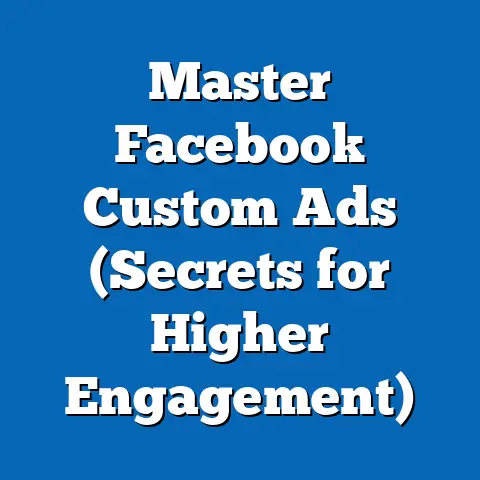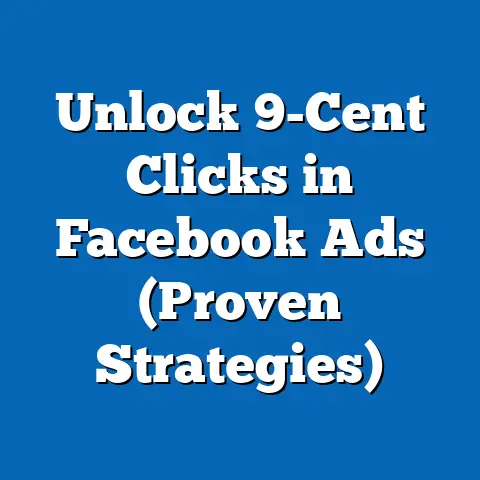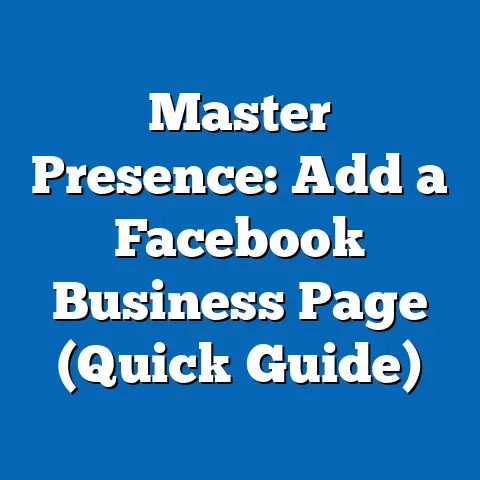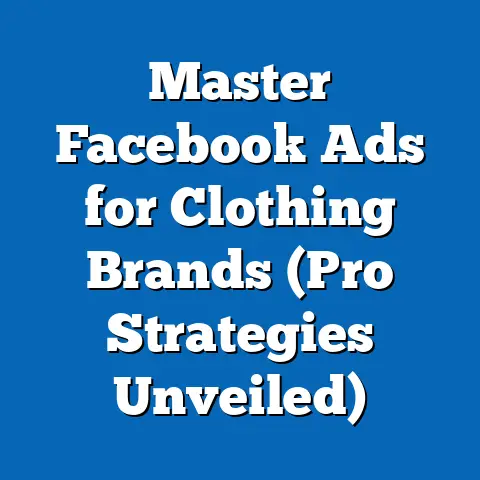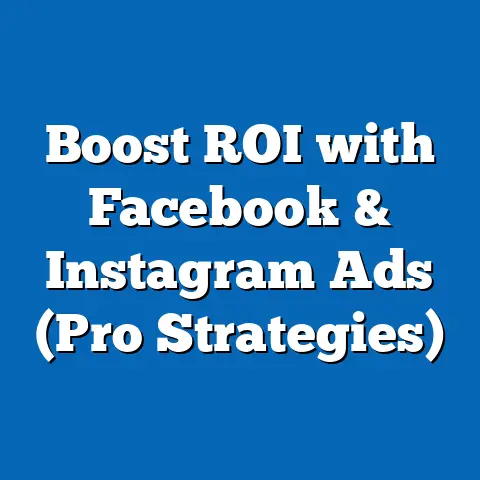Maximize Facebook Ad Performance (Data Insights Unveiled)
Maximize Facebook Ad Performance: Data Insights Unveiled
Why do some Facebook ads take off like a rocket, while others sputter and crash? It’s a question that keeps many marketers up at night. I’ve seen it firsthand – the frustration etched on faces when a carefully crafted campaign yields disappointing results. The truth is, in the ever-evolving landscape of Facebook advertising, gut feelings and hunches simply aren’t enough.
Think about it: businesses are pouring billions into Facebook ads, yet studies show that a significant portion of that investment is wasted on ineffective campaigns. It’s like throwing money into a black hole! This disparity highlights a critical need: a data-driven approach to Facebook advertising.
That’s where data insights come in. They’re the compass and map that guide you through the complex terrain of Facebook’s advertising platform, helping you navigate the algorithm, understand your audience, and optimize your creatives for maximum impact.
In this guide, I’m going to peel back the layers of Facebook advertising and show you how to harness the power of data to skyrocket your ad performance. We’ll cover everything from understanding the Facebook ad ecosystem to advanced targeting strategies and creative optimization. By the end, you’ll have a clear roadmap for leveraging data to make smarter decisions, improve your ROI, and achieve your advertising goals.
Section 1: Understanding Facebook’s Ad Ecosystem
Before we can even think about data, we need to grasp the fundamentals of Facebook’s advertising platform. It’s a complex beast, but once you understand its core components, you’ll be well on your way to success.
At its heart, Facebook advertising revolves around three key elements:
- Targeting: Who are you trying to reach? Facebook offers an unparalleled range of targeting options, from demographics and interests to behaviors and connections.
- Bidding: How much are you willing to pay to show your ad to your target audience? You can choose from various bidding strategies, each with its own pros and cons.
- Ad Formats: What type of ad are you using? Facebook offers a variety of ad formats, including image ads, video ads, carousel ads, and more.
Underpinning all of this is the Facebook algorithm, the invisible hand that determines which ads are shown to which users. It’s a constantly evolving system, but its primary goal is to deliver the most relevant and engaging content to each individual user. This means that your ads need to be not only visually appealing but also highly relevant to your target audience.
Understanding audience behavior is paramount. With billions of users worldwide, Facebook offers a wealth of data on user demographics, interests, and online activities. By tapping into this data, you can gain valuable insights into what makes your target audience tick. What are their pain points? What are their aspirations? What kind of content do they engage with most?
Finally, it’s crucial to understand the customer journey. Where do your Facebook ads fit into the overall path that customers take from initial awareness to final purchase? Are you using ads to drive brand awareness, generate leads, or directly sell products? Each stage of the customer journey requires a different approach, and your ads should be tailored accordingly.
Takeaway: Facebook’s ad ecosystem is a complex but powerful tool. Understanding the key components – targeting, bidding, ad formats, the algorithm, audience behavior, and the customer journey – is essential for building effective campaigns.
Section 2: The Power of Data Analytics
Now that we’ve laid the groundwork, let’s talk about the heart of this whole process: data analytics. This is where the magic happens, where raw numbers are transformed into actionable insights that can dramatically improve your ad performance.
Facebook provides a range of data analytics tools to help you track and measure your campaigns. These include:
- Facebook Ads Manager: This is your central hub for creating, managing, and analyzing your Facebook ads. It provides a wealth of data on key metrics like impressions, clicks, conversions, and cost per result.
- Facebook Analytics: While now sunsetted, it’s important to understand its legacy. It offered a broader view of your audience’s behavior across your website, app, and Facebook page.
- Third-Party Tools: Many third-party tools offer advanced analytics and reporting features that can complement Facebook’s native tools. Some popular options include Google Analytics (when integrated with Facebook), and social media management platforms with analytics dashboards.
Interpreting key metrics is crucial. Here are a few of the most important ones to keep an eye on:
- CTR (Click-Through Rate): This measures the percentage of people who saw your ad and clicked on it. A high CTR indicates that your ad is relevant and engaging to your target audience.
- CPC (Cost Per Click): This measures the average cost you pay for each click on your ad. A low CPC indicates that you’re targeting the right audience and that your ad is cost-effective.
- ROAS (Return on Ad Spend): This measures the revenue you generate for every dollar you spend on advertising. A high ROAS indicates that your ads are driving profitable results.
A/B testing is your secret weapon. This involves creating multiple versions of your ad with slight variations (e.g., different headlines, images, or call-to-actions) and then testing them against each other to see which performs best. A/B testing allows you to identify the most effective elements of your ad and continuously refine your strategy.
I remember working with a client who was struggling to generate leads through their Facebook ads. After conducting A/B testing on their ad copy, we discovered that using a more direct and benefit-oriented headline increased their lead generation rate by over 50%! That’s the power of data in action.
Case Study: A local bakery ran two versions of an ad, one with a close-up of a chocolate cake and another with a picture of assorted pastries. The chocolate cake ad had a 70% higher click-through rate and double the conversions. This simple test revealed that their audience was more interested in chocolate cake than other pastries.
Takeaway: Data analytics is the key to unlocking the true potential of your Facebook ads. By tracking key metrics, conducting A/B tests, and using the right tools, you can gain valuable insights into what’s working and what’s not, allowing you to optimize your campaigns for maximum performance.
Section 3: Targeting and Segmentation Strategies
Now, let’s talk about targeting – one of the most powerful features of Facebook advertising. Gone are the days of blindly throwing ads at a generic audience. With Facebook, you can laser-target your ads to reach the people who are most likely to be interested in your products or services.
Facebook offers a wide range of targeting options, including:
- Demographics: Target users based on age, gender, location, education, and other demographic factors.
- Interests: Target users based on their interests, hobbies, and passions.
- Behaviors: Target users based on their online behavior, such as purchase history, website visits, and app usage.
- Connections: Target users who are connected to your Facebook page or who are friends with people who are connected to your page.
- Custom Audiences: This allows you to upload your own customer data (e.g., email lists, phone numbers) and target users who match that data.
- Lookalike Audiences: This allows you to create a new audience that is similar to your existing customer base.
Audience segmentation is crucial. Not all customers are created equal. By segmenting your audience into smaller, more homogenous groups, you can tailor your ads to their specific needs and interests. For example, you might segment your audience based on age, gender, location, or purchase history.
Leveraging data to identify high-value customer segments is key. Which customer segments are most likely to convert? Which segments have the highest lifetime value? By analyzing your data, you can identify these high-value segments and focus your advertising efforts on them.
Personalized ad experiences are the future. In today’s world, consumers expect personalized experiences. By using data to understand your audience’s preferences and tailor your ads accordingly, you can create more engaging and effective campaigns.
I once worked with an e-commerce client who was selling fitness apparel. By analyzing their customer data, we discovered that their female customers were more interested in yoga apparel, while their male customers were more interested in weightlifting apparel. By creating separate ad campaigns targeting each segment with relevant products, we were able to increase their sales by over 30%.
Success Story: A subscription box company used Facebook’s targeting to segment their audience by interest (e.g., beauty, cooking, fitness). They then created ads featuring products relevant to each interest group. This targeted approach resulted in a 40% increase in sign-ups compared to their previous generic ads.
Takeaway: Targeting and segmentation are essential for reaching the right audience with the right message. By leveraging Facebook’s targeting options and segmenting your audience based on data, you can create more personalized and effective ad experiences that drive results.
Section 4: Creative Optimization Through Data
Now that you’ve mastered targeting, let’s talk about the creative side of Facebook advertising. After all, even the most well-targeted ad will fall flat if the creative isn’t compelling.
Data can inform creative decisions, from visuals to ad copy. What kind of images resonate with your target audience? What kind of language do they respond to? By analyzing your data, you can gain valuable insights into what makes your audience tick and use that information to create more effective ads.
Testing different creative variations is crucial. Don’t be afraid to experiment with different headlines, images, and call-to-actions. A/B testing is your friend here. By testing different creative variations, you can identify the most effective elements of your ad and continuously refine your strategy.
Storytelling and emotional connection are vital. In today’s world, consumers are bombarded with ads. To stand out from the crowd, you need to tell a compelling story that resonates with your audience on an emotional level. Data can help you understand what kind of stories your audience responds to and how to craft those stories in a way that drives engagement.
Measuring creative performance is key. How are people reacting to your ads? Are they clicking on them? Are they engaging with them? By tracking key metrics like click-through rate, engagement rate, and conversion rate, you can measure the performance of your creative and identify areas for improvement.
I remember working with a non-profit organization that was struggling to raise donations through their Facebook ads. After analyzing their data, we discovered that ads featuring personal stories of people who had been helped by the organization were far more effective than ads featuring generic statistics. By focusing on storytelling and emotional connection, we were able to increase their donation rate by over 100%.
Tools and Techniques: Use Facebook’s Ad Library to see what types of ads are performing well in your industry. Conduct surveys or polls to get direct feedback on your ad creatives. Use heatmaps to analyze how users are interacting with your landing pages after clicking on your ads.
Takeaway: Data can be a powerful tool for optimizing your creative. By using data to inform your creative decisions, test different variations, and measure performance, you can create more engaging and effective ads that drive results.
Section 5: Continuous Improvement and Scaling
Finally, let’s talk about continuous improvement and scaling. Facebook advertising is not a “set it and forget it” kind of activity. It requires ongoing data analysis and optimization to maintain performance and achieve your goals.
Ongoing data analysis is essential. Regularly review your data to identify trends, patterns, and areas for improvement. Are your ads performing as well as they could be? Are you reaching the right audience? Are you getting the best possible ROI?
Strategies for scaling successful campaigns are key. Once you’ve identified a winning campaign, you’ll want to scale it to reach a wider audience and generate even more results. However, scaling too quickly can sometimes lead to a drop in performance. It’s important to scale gradually and monitor your results closely.
Remarketing is your secret weapon for re-engaging previous customers. This involves targeting users who have previously interacted with your website or app with relevant ads. Remarketing can be a highly effective way to drive conversions and increase customer loyalty.
Adaptability is key. The world of Facebook advertising is constantly changing. New features are introduced, algorithms are updated, and audience behaviors shift. It’s important to stay on top of these changes and adapt your strategies accordingly.
I’ve seen countless businesses fail because they got complacent and stopped paying attention to their data. Don’t let that happen to you. Commit to continuous improvement and stay adaptable to the ever-changing landscape of Facebook advertising.
Example: A clothing retailer noticed their retargeting ads were performing poorly. After analyzing the data, they realized users were seeing the same ads repeatedly. They refreshed their ad creatives and saw a 60% increase in engagement.
Takeaway: Continuous improvement and scaling are essential for long-term success in Facebook advertising. By committing to ongoing data analysis, adapting to change, and leveraging strategies like remarketing, you can maintain performance and achieve your advertising goals.
By understanding the Facebook ad ecosystem, leveraging data analytics, targeting the right audience, optimizing your creative, and committing to continuous improvement, you can transform your campaigns from “meh” to “magnificent.”
Embrace data-driven decision-making in your advertising strategies. Don’t be afraid to experiment, test, and learn from your mistakes. The more you embrace data, the more successful you’ll be.
The future of Facebook advertising is all about data. As data analytics continues to evolve, so too will the opportunities for businesses to connect with their customers in more meaningful and effective ways. Stay curious, stay adaptable, and never stop learning.
Call to Action
Want to take your Facebook advertising skills to the next level? Explore the Facebook Ads Manager Help Center, attend webinars on Facebook advertising best practices, and join communities of marketers who are passionate about data-driven advertising. The journey to mastering Facebook advertising is a continuous one, but with the right knowledge and tools, you can achieve remarkable results.

